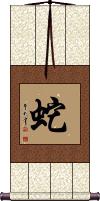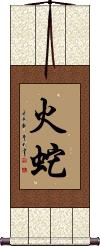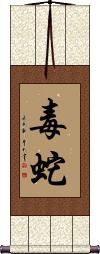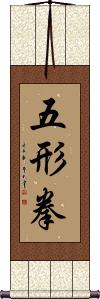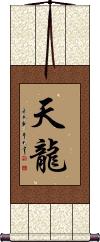Many custom options...
And formats...

Snake in Chinese / Japanese...
Buy a Snake calligraphy wall scroll here!
Personalize your custom “Snake” project by clicking the button next to your favorite “Snake” title below...
Snake / Serpent
Year of the Snake / Zodiac Sign
蛇 is the character for snake or serpent in Chinese, old Korean, and Japanese.
If you were born in the year of the snake, you . . .
Are calm.
Are an inspiration to others.
Have a stubborn nature like a mule (you do not like to concede).
See also our Chinese Zodiac page.
Fire Snake
Viper
Poisonous Snake
毒蛇 is the Chinese, Japanese Kanji, and old Korean Hanja for viper.
While 毒蛇 usually means viper, it may be used by some to refer to any poisonous snake or poisonous serpent.
Wu Xing Fist
Five Forms Fist of Kung Fu
Celestial Dragon / Tian Long
天龍 can mean Heavenly Dragon (Dragon of Heaven), Sky Dragon, Holy Dragon, Celestial Dragon, or Divine Dragon.
This can be a given name in both China and Japan (天龍 is pronounced Tenryū and sometimes written 天竜 in Japanese).
In an older Buddhist context, this can refer to Brahma, Indra, and the devas, together with the nāgas. It can also refer to celestials and snake spirits.
The Five Animals
Dragon Snake Tiger Leopard Crane
龍蛇虎豹鶴 is a list of the Chinese characters for the five animals of Shaolin Kung Fu in a comfortable order (meaning that they are in the proper order and will “feel right” to a Chinese person who views this arrangement).
This in-stock artwork might be what you are looking for, and ships right away...
Gallery Price: $67.00
Your Price: $36.88
These search terms might be related to Snake:
First Turn of the Dharma Wheel
In the Abyss of Infinite Bitterness - Turn to the Shore
Kamikaze / Divine Wind
Makaze / True Wind
Mujo No Kaze / Wind of Impermanence
Overcome: Regardless of the Rain and Wind
Wind
Wind and Rain
Wind of Change
Wind Warrior
Wind Wheel
Not the results for Snake that you were looking for?
Below are some entries from our dictionary that may match your Snake search...
| Characters If shown, 2nd row is Simp. Chinese |
Pronunciation Romanization |
Simple Dictionary Definition |
蛇 see styles |
yí yi2 i hebi へび |
More info & calligraphy: Snake / Serpent(1) (じゃ is more associated with serpent and large snakes) snake; (2) serpent; large snake; (surname) Hebi sarpa, a serpent, snake. |
龍 龙 see styles |
lóng long2 lung riyou / riyo りよう |
More info & calligraphy: Dragon(out-dated kanji) (1) dragon (esp. a Chinese dragon); (2) naga; semi-divine human-cobra chimera in Hindu and Buddhist mythology; (personal name) Riyou A dragon, dragon-like, imperial; tr. for nāga, which means snake, serpent; also elephant, elephantine, serpent-like, etc., cf. 那. |
ヘビ see styles |
hebi ヘビ |
More info & calligraphy: Hebi |
天龍 天龙 see styles |
tiān lóng tian1 long2 t`ien lung tien lung tenryuu / tenryu てんりゅう |
More info & calligraphy: Celestial Dragon / Tian LongDevas, including Brahma, Indra, and the devas, together with the nāgas. |
小龍 小龙 see styles |
xiǎo lóng xiao3 long2 hsiao lung |
More info & calligraphy: Little Dragon |
毒蛇 see styles |
dú shé du2 she2 tu she dokuja; dokuhebi どくじゃ; どくへび |
More info & calligraphy: Vipervenomous snake; poisonous snake A poisonous snake.; Poisonous snakes, the four elements of the body— earth, water, fire, wind (or air)— which harm a man by their variation, i. e. increase and decrease. Also, gold. |
水蛇 see styles |
shuǐ shé shui3 she2 shui she |
More info & calligraphy: Water Snake |
マンバ see styles |
manba マンバ |
More info & calligraphy: Manba |
五形拳 see styles |
gokeiken / gokeken ごけいけん |
More info & calligraphy: Wu Xing Fist |
巳 see styles |
sì si4 ssu mi み |
6th earthly branch: 9-11 a.m., 4th solar month (5th May-5th June), year of the Snake; ancient Chinese compass point: 150° (1) the Snake (sixth sign of the Chinese zodiac); the Serpent; (2) (obsolete) (See 巳の刻) hour of the Snake (around 10am, 9-11am, or 10am-12 noon); (3) (obsolete) south-southeast; (4) (obsolete) fourth month of the lunar calendar; (female given name) Mi snake |
虺 see styles |
huǐ hui3 hui |
mythical venomous snake |
蚹 see styles |
fù fu4 fu |
scales on the belly of a snake, aiding locomotion; snail; to crawl |
蛻 蜕 see styles |
tuì tui4 t`ui tui monuke もぬけ nukegara ぬけがら |
skin cast off during molting; exuvia; to pupate; to molt; to slough; to cast off an old skin or shell shed skin of snake, insect, etc. (also place left behind); cast-off skin (snake, insect, etc.); husk; empty shell; exuvia; exuviae |
蝮 see styles |
fù fu4 fu mamushi; mamushi; hami(ok); kuchibami(ok); tajihi(ok) マムシ; まむし; はみ(ok); くちばみ(ok); たじひ(ok) |
insect; poisonous snake (archaic) (kana only) (See クサリヘビ) pit viper (esp. the mamushi, Gloydius blomhoffi) |
蠎 see styles |
mǎng mang3 mang uwabami うわばみ |
old variant of 蟒[mang3] (1) (kana only) large snake; (2) (colloquialism) (kana only) heavy drinking; heavy drinker |
镻 see styles |
dié die2 tieh |
name of poisonous snake in ancient text |
鱗 鳞 see styles |
lín lin2 lin rin りん |
scales (of fish, snakes etc) (1) (kana only) scale (of fish, snake, etc.); (2) (kana only) serif (on kana or kanji (e.g. in Mincho font)); (female given name) Rin |
鵺 see styles |
yè ye4 yeh nue ぬえ |
a kind of bird similar to pheasant (1) Japanese chimera; mythical creature with a monkey's head, tanuki's body, tiger's limbs, and a snake tail; (2) White's thrush (Zoothera dauma); (3) man of mystery; enigma; (female given name) Nue |
一揃 see styles |
pinzoro; pinzoro ピンぞろ; ピンゾロ |
(kana only) (See ピン・1) roll of all ones (dice); snake eyes |
丁巳 see styles |
dīng sì ding1 si4 ting ssu hinotomi; teishi / hinotomi; teshi ひのとみ; ていし |
fifty-fourth year D6 of the 60 year cycle, e.g. 1977 or 2037 (See 干支・1) Fire Snake (54th term of the sexagenary cycle, e.g. 1917, 1977, 2037) |
三性 see styles |
sān xìng san1 xing4 san hsing sanshō |
The three types of character 善, 惡, 無記 good, bad and undefinable, or neutral; v. 唯識論 5. Also, 徧依圓三性 the three aspects of the nature of a thing— partial, as when a rope is mistaken for a snake; only partly reliable, i.e. incomplete inference, as when it is considered as mere hemp; all around, or perfect, when content, form, etc., are all considered. |
乙巳 see styles |
yǐ sì yi3 si4 i ssu otomi おとみ |
forty-second year B6 of the 60 year cycle, e.g. 1965 or 2025 (See 干支・1) Wood Snake (42nd term of the sexagenary cycle, e.g. 1905, 1965, 2025); (given name) Otomi |
咬傷 咬伤 see styles |
yǎo shāng yao3 shang1 yao shang koushou / kosho こうしょう |
bite (e.g. snake bite, mosquito bite) bite wound; bite |
地潜 see styles |
jimuguri じむぐり |
(kana only) Japanese forest rat snake (Euprepiophis conspicillatus, Elaphe conspicillata); burrowing rat snake |
大蛇 see styles |
daija だいじゃ |
big snake; (large) serpent; (personal name) Daija |
己巳 see styles |
jǐ sì ji3 si4 chi ssu tsuchinotomi; kishi つちのとみ; きし |
sixth year F6 of the 60 year cycle, e.g. 1989 or 2049 (See 干支・1) Earth Snake (6th term of the sexagenary cycle, e.g. 1929, 1989, 2049) |
巳年 see styles |
midoshi; hebidoshi みどし; へびどし |
year of the snake |
巳蛇 see styles |
sì shé si4 she2 ssu she |
Year 6, year of the Snake (e.g. 2001) |
抜殻 see styles |
nukegara ぬけがら |
(irregular okurigana usage) cast-off skin (snake, insect, etc.); husk; empty shell; exuvia; exuviae |
抽取 see styles |
chōu qǔ chou1 qu3 ch`ou ch`ü chou chü |
to extract; to remove; to draw (a sales commission, venom from a snake etc) |
Click here for more Snake results from our dictionary
The following table may be helpful for those studying Chinese or Japanese...
| Title | Characters | Romaji (Romanized Japanese) | Various forms of Romanized Chinese | |
| Snake Serpent | 蛇 | hebi | shé / she2 / she | |
| Fire Snake | 火蛇 | hi hebi / hihebi | huǒ shé / huo3 she2 / huo she / huoshe | |
| Viper | 毒蛇 | doku hebi / dokuhebi | dú shé / du2 she2 / du she / dushe | tu she / tushe |
| Wu Xing Fist | 五形拳 | gokeiken | wǔ xíng quán wu3 xing2 quan2 wu xing quan wuxingquan | wu hsing ch`üan wuhsingchüan wu hsing chüan |
| Celestial Dragon Tian Long | 天龍 天龙 | tenryuu / tenryu | tiān lóng tian1 long2 tian long tianlong | t`ien lung tienlung tien lung |
| The Five Animals | 龍蛇虎豹鶴 龙蛇虎豹鹤 | ryuu hebi tora hyou tsuru ryuuhebitorahyoutsuru ryu hebi tora hyo tsuru | lóng shé hǔ bào hè long2 she2 hu3 bao4 he4 long she hu bao he longshehubaohe | lung she hu pao ho lungshehupaoho |
| In some entries above you will see that characters have different versions above and below a line. In these cases, the characters above the line are Traditional Chinese, while the ones below are Simplified Chinese. | ||||
Successful Chinese Character and Japanese Kanji calligraphy searches within the last few hours...
